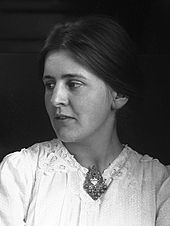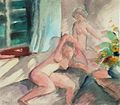Dorothea Maetzel-Johannsen
Dorothea Maetzel-Johannsen (born February 6, 1886 in Lensahn , † February 8, 1930 in Hamburg ) was a German modern painter . She was a co-founder of the Hamburg Secession . From 1919 she created her main expressionist works.
life and work
As a child, Dorothea Maetzel-Johannsen fell ill with rheumatoid arthritis , which resulted in a chronic heart condition. From an early age she was intensively involved in drawing and painting. From 1907 to 1909 she trained as a drawing teacher in Hamburg and then worked at a school in Schleswig . In addition, she created free works in various styles. In 1910 she married the Hamburg architect and painter Emil Maetzel . As a married woman, she was no longer allowed to work as a teacher in the Wilhelmine Empire and had to give up her job.

Maetzel-Johannsen developed his own handwriting based on the French painter Cézanne , for which a strictly structured picture structure is typical. In doing so, she included the brushstroke in the design. At the same time, she also created very painterly works that go back to German open-air painting . The two-dimensional effect became the determining formal element here. A third work area shows works in which she again gave the line a strong meaning.
Between 1911 and 1918 she repeatedly traveled to Berlin . During the First World War she took lessons from Lovis Corinth . After the end of the war, a successful time began for the artist couple in Hamburg. Together with her husband, Maetzel-Johannsen was one of the founders of the Hamburg Secession in 1919 . In 1920 she and her husband joined the Hamburg art community .
Starting from the works of the dissolved artist community Brücke (artist group) , from early Cubism as well as African sculpture , she created her main expressionist work from 1919 . In doing so, she developed an individual style of expression within Expressionism. Although the typical angular contours , the two-dimensional spatial conception and dynamic oblique compositions can be found in her works , unlike her colleagues, the artist dispensed with any aggressiveness in her compositions. A contemplative mood resonates in the still lifes and figure pictures, which contradicts the dynamic picture structure.
In 1921 Maetzel-Johannsen moved into her own studio in Hamburg, in Ulmenau 3. Here she created works in which she emphasized the surface effect of the pictures. At the same time she dealt with the New Objectivity . She carefully incorporated the style that had spread in Germany from the mid-1920s into her work.
In 1923 she carried out the order for wall paintings in the Hamburger Kunsthalle . In 1925 she stayed in Paris and Chartres for half a year . In France , she took a large number of new ideas for her work back to Germany, which were to flow into the last five years of her work. Works were created that have Cézannesque features, other images are based on Fauvism . Finally, there is also a group of works in which she tried to include the line in the painterly. However, a predominant mood in Maetzel-Johannsen's works is a cheerful to melancholy mood that is inherent in a harmonious expression.
In 1929 she made another trip to Visby on the island of Gotland .
In 1930 Maetzel-Johannsen worked on a commissioned design for a ceiling painting in the Hamburg planetarium . She was denied execution because she died on February 8, 1930 at the age of 44 after an operation of cardiac insufficiency . In addition to her husband, she had four children: Ruth (* July 21, 1911; † October 22, 2002), Bogumil (* 1913; † November 1989), Peter (* 1915; † July 1940) and Monika (* 1917; † 10 October 2010). As in the case of other women in art , her work was largely forgotten. A monograph by Jan Buchholz and Doris von Zitzewitz on the artist's life and work was only published in 2014 .
A tombstone for Dorothea Maetzel-Johannsen and her husband can be found in Hamburg's Ohlsdorf cemetery , grid square S 12 (near Chapel 1).
Honors
- In August 2017, the Hamburg Senate decided to provide some existing street signs with an information sign in order to additionally honor the female relatives, this also applies to the Maetzelweg in Hamburg-Volksdorf.
- selection
Exhibitions
- 1926: Joint exhibition with the sculptor Friedrich Wield , Hamburger Kunsthalle
- 1958: Emil Maetzel - Dorothea Maetzel-Johannsen , Kunstverein Hamburg
- 2016: group exhibition. Empathy and abstraction. The modern age of women in Germany; Bielefeld art gallery
- 2019: A modern artist couple: Emil Maetzel and Dorothea Maetzel-Johannsen , Edwin Scharff Museum , Neu-Ulm
Remarks
- ↑ Jan Buchholz; Doris von Zitzewitz: Dorothea Maetzel-Johannsen. Life and work . Hamburg and Neumünster 2014, ISBN 978-3-529-02856-4
- ↑ Empathy and abstraction. The modern age of women in Germany. Exhibition in the Kunsthalle Bielefeld, Oct. 2015 - Feb. 2016, accessed on April 28, 2016
- ↑ Marcus Golling: New exhibition in Neu-Ulm shows pictures of a marriage. Augsburger Allgemeine , November 22, 2019, accessed on November 22, 2019 .
literature
sorted by year of publication
- Rolf Spörhase: Dorothea Maetzel-Johannsen . In: Der Kreis , Vol. 3, 1926
- Dorothea Maetzel-Johannsen, self-portrait in letters . In: Der Kreis , vol. 8, 1931
- Catalog for the exhibition Emil Maetzel - Dorothea Maetzel-Johannsen , Kunstverein Hamburg 1958
- Mathias F. Hans: Dorothea Maetzel-Johannsen, monograph and work catalog , Hamburg 1986
- The Josef-Herrmann Bunte Collection , Hamburg 1999, pp. 48–50.
- Emil Maetzel, Dorothea Maetzel-Johannsen. An artist couple from the Hamburg Secession. Expressionist works , Hamburg 2002
- Friederike Weimar: The Hamburg Secession, 1919–1933. History and artist lexicon, Fischerhude 2003, pp. 126–127
- Friederike Weimar: water reflections. “The Eye of God” in the garden of the Maetzel family of artists . In: Die Gartenkunst 20 (1/2008), pp. 219–224.
- Jan Buchholz; Doris von Zitzewitz: Dorothea Maetzel-Johannsen. Life and work . Hamburg and Neumünster 2014, ISBN 978-3-529-02856-4
- Karin von Behr: Dorothea Maetzel-Johannsen. Gleanings. Life and work . Kiel / Hamburg 2016, ISBN 978-3-529-03437-4
Web links
| personal data | |
|---|---|
| SURNAME | Maetzel-Johannsen, Dorothea |
| BRIEF DESCRIPTION | German painter |
| DATE OF BIRTH | February 6, 1886 |
| PLACE OF BIRTH | Lensahn |
| DATE OF DEATH | February 8, 1930 |
| Place of death | Hamburg |
















